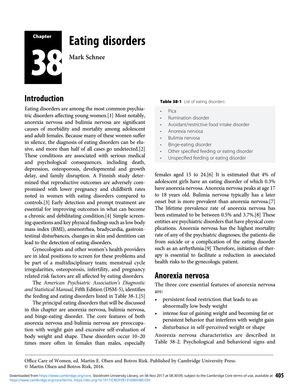Overview of Eating Disorders: Anorexia Nervosa, Bulimia Nervosa, and Binge-Eating Disorder
May 2016
in “
Cambridge University Press eBooks
”

TLDR Eating disorders are serious, often undiagnosed conditions requiring early treatment, with anorexia being the most deadly and binge-eating the most treatable.
The document from June 6, 2016, provides an overview of eating disorders, particularly anorexia nervosa, bulimia nervosa, and binge-eating disorder, highlighting their prevalence, potential causes, and serious health consequences. It emphasizes the importance of early detection and treatment, noting that over half of all cases remain undiagnosed. Anorexia nervosa has a lifetime prevalence rate of 0.5% to 3.7% and the highest mortality rate of any psychiatric diagnosis, while bulimia nervosa is more common and typically starts later in life. Binge-eating disorder involves recurrent episodes of binge eating without compensatory behaviors and responds better to treatment. The document also discusses the medical complications of eating disorders, which can affect every organ system, and the role of genetics and brain structure in their pathogenesis. It mentions the SCOFF questionnaire as a screening tool and underscores the necessity of a multidisciplinary treatment approach. For bulimia nervosa, cognitive behavioral therapy and SSRIs have been found effective in reducing binge eating, vomiting, and improving mood and anxiety.
